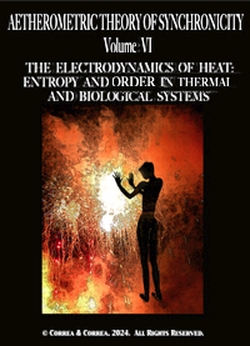![Akronos logo]](/images/akronos_wheel.jpg)
|
Akronos Publishing Concord, ON, Canada www.aetherometry.com |
![Akronos logo]](/images/akronos_wheel.jpg)
|
Akronos Publishing Concord, ON, Canada www.aetherometry.com |

An Algebra of Discernible Quantities: Entropy, Heat and Work -
and the Operation of Carnot and Stirling Heat Engines
by Correa, Paulo N.; Correa, Alexandra N.; Askanas, Malgosia
Published in August 2025. 182 pages.
Aetherometric Theory of Synchronicity, Vol. 6
Monograph AS3-VI.6
Price: US $40
|
ABSTRACT
A new and radically different treatment of the fundamental notions of classical and modern thermodynamics - entropy, work, heat transfer and the ideal and Stirling heat engines - is proposed. Based on new findings in experimental and analytical electrodynamics and thermokinetics, it replaces the calculus of infinitesimal quantities with the aetherometric algebra of discernible quantities. It treats changes in work and gas configurations as massfree energy processes that can alter the state of electromagnetic and molecular heats. It refines, in particular, the functions responsible for isothermal and adiabatic transitions, to permit exact determination of curve isometry and the real inflection points. The authors claim discovery of the energy flux, whether in the form of heat or work, that drives all isothermal transitions with a given volume expansion (or compression) factor. They demonstrate that in adiabatic transitions, work results from changes in the electromagnetic heat of state, and not in the isochoric heat of state. A realistic simulation of Carnot's ideal heat engine and the Stirling engine prove that only the molar electromagnetic component of heat is converted into mechanical work, whereas work can be converted into both molar electromagnetic and thermokinetic heats (Joule paradox). Along an isotherm, heat and work are entirely reversible, but between isotherms - as in a heat engine - heat and work are never reversible. Then the authors show how this was irrelevant to Clausius' demonstration of an absolute temperature scale, which was solely based upon the relation between the two isothermal steps of the ideal heat engine. The most important finding, however, is the discovery that adiabatic, isochoric and isobaric transitions can be deployed in such a manner as to promote the conversion of thermokinetic heat (the change in isochoric heat) into so-called "latent heat". The latter turns out to be the electrokinetic energy of ion pairs that may technically be separated into plasmas. The authors conduct a vacuum experiment that formally demonstrates this to be the case. These findings lead them to the contention that in the Carnot cycle the real reversible heat is not the useful heat that is converted into work, but any change in the isochoric heat of state that may be conserved by a reversible conversion into ion electricity. They propose a novel and correct analysis of Stirling engines, and demonstrate how the optimized Stirling engine entirely conforms to the real criteria of an ideal heat engine. |